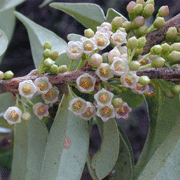James L. Luteyn and Paola Pedraza-Peñalosa
The New York Botanical Garden
|
|
Diogenesia is a neotropical genus of 13 species, ranging from Venezuela to northern Bolivia. It is seemingly closely related to Sphyrospermum. |
Eleutherostemon Herzog, Meded. Rijksherb. Leiden 27: 22. 1915, non Klotzsch (1838). Type: Eleutherostemon racemosum Herzog [=Diogenesia racemosa (Herzog) Sleumer].
Small shrubs, usually epiphytic, with slender,
often elongate and pendent branches, occasionally climbing. Leaves
alternate, subcoriaceous to coriaceous, margin entire, 3-5-plinerved, short-petiolate;
bud scales generally distinct (=Sleumer's pseudostipule). Inflorescences
axillary, in few- to many-flowered fascicles or racemes, very rarely reduced
to a solitary flower; pedicel slender, bibracteolate about midway
along pedicel. Flowers 4-5-merous, without odor; aestivation
valvate; calyx continuous with pedicel; hypanthium campanulate,
rounded at base, truncate at apex, smooth or indistinctly 5-ribbed;
limb and lobes short, suberect; corolla cylindric, urceolate or campanulate,
shortly lobed to -partite halfway; stamen 4, 5, 6, 8 or 10, equal
in length, ± as long as or slightly shorter than corolla;
filaments distinct, longer or shorter than anthers, lacking spurs, pubescent;
anthers oblong, lacking disintegration tissue; thecae smooth or faintly
granular; tubules as long as or longer than the thecae, dehiscing
by an introrse oval pore or cleft; pollen lacking viscin threads;
nectariferous disc usually prominent, thick-annular, entire or crenulate,
rarely conical; ovary inferior; style slender, equalling the
corolla in length or long-exserted; stigma truncate. Fruit
a juicy berry, subglobose, when immature pericarp thin and
brittle, when mature subcoriaceous, usually purple to blue-black;
seeds numerous, the embryo green.
A genus of 13 species ranging from Venezuela to northern Bolivia.
Key to Neotropical Species Back to Top
Sorry, there is no taxonomic treatment for Demosthenesia at the moment, and these are James L. Luteyn's unpublished notes.
